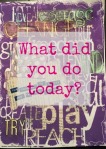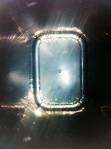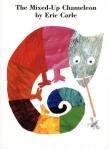
Sometimes these five seemingly innocuous words breed frustration, silence or worse, “nothing”. As a parent, being able to connect with your child’s day at school is important. Not in a “I figured out what I want to be when I grow up” kind of day, but in a social connection way. Understanding that people have different experiences and can share them is a powerful idea. It leads to conversations and connections, both important milestones in communication development. I don’t need the minutiae of bathroom details, but the meat of the day helps.
It is a tension point sometimes for teachers to add one more thing to their to-do lists, but your speech therapist (or OT or para-pro) can help. My fellow speechies developed a simple checklist that went home once a week for our group thematic activities. We would follow a theme calendar and then give feedback on the child’s participation, any verbalizations or new skills we saw (hurray!), things that worked well and things that didn’t go smoothly. We also had some visuals for their emotional state and room to comment if we figured out new tricks to share with mom and dad. A quick email from home on a Monday morning about the weekend activities is always helpful too!
For my older students, I often ask them to use their technology to share about their weekends or breaks (instagram pictures are a great prompt…teacher friendly please!) or to help them create personal blogs or storyboards. They are often doubtful when I suggest sharing these with their families as their perception is that mom and dad won’t care. Surprise, we do!!
Over breaks and summer, I suggest that my parents to get a cheap flip picture book like this one: 
This one was from Walmart and was less than ten dollars. You can also find them at Dollar stores for much less and build a library of memory books. This is an easy way to talk about a vacation or what happened while the student was on break. It also is a good visual prep for visiting family you don’t see very often (Look, remember when we went to visit your cousins? We had so much fun swimming at their house!) to reduce anxiety.
For more tech savvy parents, you can use a site like Shutterfly to create permanent photo books for your adventures. There is also a new app called Steller that you can take a peek at to create visual story telling on your iphone (it has a save feature for future viewings). Even Pinterest can be used to create secret boards all about your adventures and can be shared only with who you invite to view it (teachers, grandparents, therapists). So next time you ask “What did you do today?”, you just might get more than you asked for!
What communication tools work for you?




